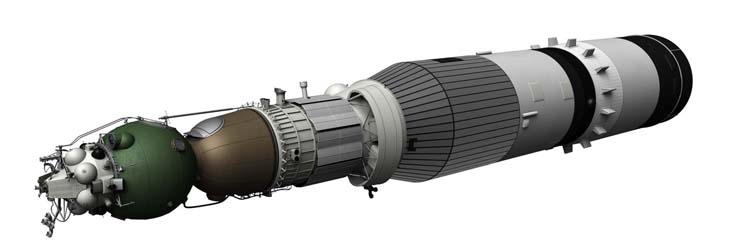
The history of the N-


The Initial Stages
On June 23, 1960 the USSR gave the go ahead to the N-
This initial design while a powerful heavy lift rocket, had a planned payload capacity
of 75 tonnes -
It was to use liquid-
But note that date almost a full year before the flight of Yuri Gagarin.
But even before this date, there had been major disputes and changes. Originally Sergei Korolev had approached Valentin Glushko to design the engines for his heavy lift rocket. The men had previously been friends, but heated arguments broke out over this project.
Glushko was easily the most experienced rocket engine designer in the USSR, and he demanded the use of advanced propellants like hypergolics. Korolev thought that these were dangerous, and much too difficult to handle. They had a blazing row in front of the politburo, and Glushko point black refused to work on the project.He took the whole thing very personally, and never forgave Korolev for this perceived insult.
Korolev had to find someone else to make his rocket engines.
He chose Nikolai Kuznetsov, who had considerable experience building jet aircraft engines, but had not built a rocket engines. Because it is a lot harder to build a big rocket engine than a small one, Kuznetsov’s solution had a large number of smaller engines. It also required a complex system, KORD, to control the engines. This was to prove a major issue in flight.
Despite problems that came to light later, there are many advantages to this design. Apart from simpler and easier to develop engines, a wide base with a ring of engines around the edge means it is practical to steer the whole rocket by throttling the engines.
Korolev wanted to store the propellants in spherical tanks, which would be easy to
make strong. The required relative size of the oxygen and kerosene tanks lead to
a conical design for each stage, and this combined with the ring of engines gave
the N-
The main visible design difference at this stage was that the first stage lacked the inner ring of 6 engines.
Make notes on changes before the first launch, to increase payload.
Notes on the design -
The first launch.
Changes made after the first launch.
The second launch, pad destruction.
Changes made for the 3rd launch.
3rd launch.
Changes made for the 4th launch.
4th launch.
N1-
There were four attempts to launch an N-
• February 21, 1969: Exploded at 12,200 m altitude, 69 seconds after lift-
• July 3, 1969: At lift-
• June 24, 1971: Vehicle serial number 6L -
• November 22, 1972: Vehicle serial number 7L -
This page under development…